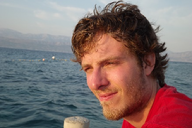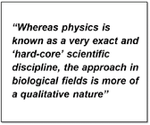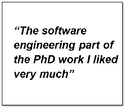 In this thesis the assembly of clathrin coats in the presence of adaptor proteins was studied, through computer simulations in coarse-grained models and through statistical mechanics. ‘We aimed at reproducing and studying the minimal conditions that lead to the successful formation of functional aggregates,’ Matteo Giani says.
In this thesis the assembly of clathrin coats in the presence of adaptor proteins was studied, through computer simulations in coarse-grained models and through statistical mechanics. ‘We aimed at reproducing and studying the minimal conditions that lead to the successful formation of functional aggregates,’ Matteo Giani says.
At first a coarse grained model of proteins was introduced, inspired by and representing the clathrin triskelion and AP2 complex. These proteins work on the cell membrane, to create polyhedric coats in order to internalize cargo.
‘The simulation method on the early stages of clathrin aggregation at a membrane, led to two scientific papers,’ Matteo says. ‘This modelling work was never done before. The role of several proteins and interaction strengths was considered and put into an effective and explicit model.’
The computer simulations provided novel insights into the role of AP2 in the self-assembly of clathrin cages, and suggested that the mechanical properties of adaptor proteins are of fundamental importance.
‘In all of the simulations the growth of the clathrin coat halts upon reaching a hemispherical configuration,’ Matteo says. ‘This feature hints towards the existence of an activation barrier in the free energy profile, associated with the assembly of a clathrin coat at the membrane.’
In his PhD work Matteo Giani, among other things, developed the simulation code right from scratch.
‘During the project I worked in a multidisciplinary environment including physics, biology and biochemistry,’ he says. ‘Our approach has given new insights on some functional aspects of these proteins which were discovered for the first time some forty years ago.’
Different cultures

The models are based on the available structural data, and they are engineered to capture the key elements and behaviour of the modelled proteins. Herein, for example, the effect of the flexibility of the clathrin triskelion, previously neglected, was taken into account, adding substantially to the exactness and richness of the simulation models.
Matteo: ‘I had to learn a lot about the biology on this theme. I collaborated and exchanged knowledge with various colleagues.’
 ‘In fact, I really had to bring different cultures together. Whereas physics is known as a very exact and ‘hard-core’ scientific discipline, the approach in biological fields is more of a qualitative nature. I had to develop a common language, in order to understand both worlds and to come to a theoretical model as a good base for the simulation models. Also at conferences, the audience for which I presented my work was a mixed one.’
‘In fact, I really had to bring different cultures together. Whereas physics is known as a very exact and ‘hard-core’ scientific discipline, the approach in biological fields is more of a qualitative nature. I had to develop a common language, in order to understand both worlds and to come to a theoretical model as a good base for the simulation models. Also at conferences, the audience for which I presented my work was a mixed one.’
Software engineering

Already during the last stages of his PhD work, Matteo started working at a software engineering company in the Netherlands.
‘The software engineering part of the PhD work I liked very much,’ Matteo says. ‘I’m proud to have performed this special PhD research and to have contributed to scientific progress on this very subject.

Now, however, I feel the time is right to look elsewhere and add to my experiences working in industry, in order to start a career there. The academic environment is a demanding one. But I will most certainly miss the collaboration with my colleagues from the various fields of research.’
